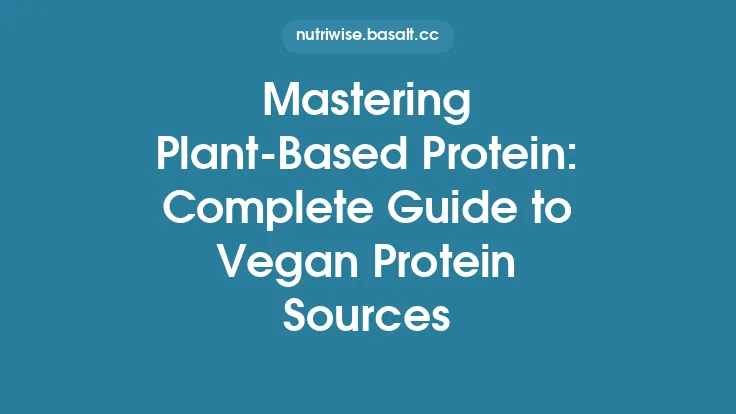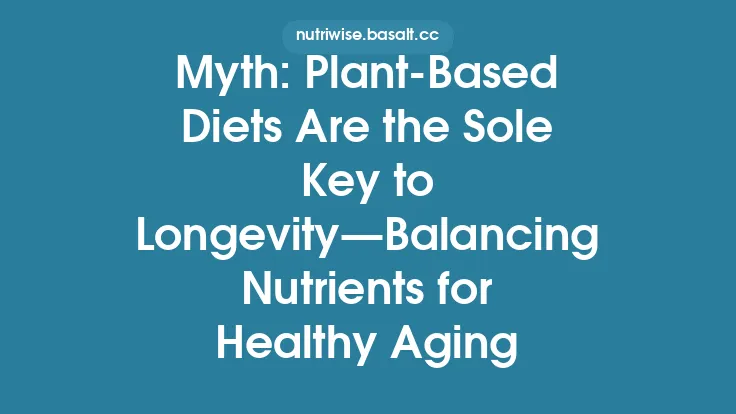Plant‑based proteins have become a cornerstone of modern nutrition, offering a versatile and sustainable way to meet the body’s protein requirements without relying on animal products. While the concept may seem straightforward—simply replace meat, dairy, and eggs with beans, nuts, and grains—the reality involves a nuanced understanding of plant protein sources, their amino acid compositions, factors that influence their digestibility, and practical strategies for building balanced meals. This article delves into the fundamentals of plant‑derived protein, providing a comprehensive guide that equips anyone—from the curious newcomer to the seasoned vegan athlete—with the knowledge needed to thrive on a plant‑centric diet.
Understanding Plant Protein Sources
Plant proteins are distributed across a wide spectrum of foods, each contributing a unique blend of macronutrients, micronutrients, and phytochemicals. Below is an overview of the most nutritionally significant categories:
| Category | Representative Foods | Typical Protein Content (per 100 g, cooked) |
|---|---|---|
| Legumes | Lentils, chickpeas, black beans, soybeans (edamame, tofu, tempeh) | 7–18 g |
| Whole Grains | Quinoa, amaranth, farro, brown rice, oats | 2–8 g |
| Nuts & Seeds | Almonds, pumpkin seeds, hemp seeds, chia seeds, peanuts | 4–25 g (dry weight) |
| Pseudocereals & Tubers | Buckwheat, sweet potatoes (when paired with legumes) | 2–5 g |
| Vegetables (high‑protein) | Green peas, broccoli, Brussels sprouts, spinach | 2–5 g |
| Algae & Fungi | Spirulina, chlorella, mushrooms, mycoprotein (e.g., Quorn) | 5–57 g (dry weight) |
Legumes and soy products dominate the plant protein landscape because of their relatively high protein density and favorable amino acid composition. Whole grains, while lower in protein per gram, provide complementary nutrients such as fiber, B‑vitamins, and minerals. Nuts and seeds excel in delivering essential fatty acids alongside protein, making them valuable for overall macronutrient balance.
Amino Acid Profiles of Common Plant Foods
All proteins are built from 20 amino acids, nine of which are essential because the body cannot synthesize them. Plant proteins typically contain all essential amino acids, but the relative proportions differ from animal proteins. Understanding these patterns helps in constructing meals that naturally supply a complete amino acid spectrum.
| Food | Limiting Essential Amino Acid (relative to human requirement) |
|---|---|
| Wheat (and most cereals) | Lysine |
| Rice | Lysine |
| Corn | Tryptophan, Lysine |
| Soy | Generally balanced (considered “complete”) |
| Peas | Methionine |
| Lentils | Methionine |
| Quinoa | Well‑balanced (complete) |
| Hemp seeds | Slightly low in lysine |
The concept of a “limiting” amino acid simply means that, relative to the others, it is present in the smallest amount. By pairing foods with complementary limiting amino acids—such as combining a lysine‑rich legume with a methionine‑rich grain—one can achieve a dietary protein profile that meets all essential amino acid needs without relying on animal products. This principle underlies many traditional cuisines (e.g., rice and beans, hummus with pita, lentil soup with barley).
Enhancing Bioavailability: Cooking, Soaking, and Fermentation
Raw plant foods often contain antinutrients—compounds that can bind minerals or interfere with protein digestion. While these substances are not inherently harmful and may even confer health benefits in moderate amounts, certain preparation techniques can markedly improve protein digestibility and nutrient absorption.
- Soaking and Sprouting
- Mechanism: Soaking legumes and grains for 8–12 hours initiates enzymatic activity that reduces phytate levels and softens cell walls. Sprouting further activates endogenous enzymes (e.g., proteases) that break down storage proteins into more readily absorbable peptides.
- Impact: Studies show a 10–20 % increase in protein digestibility for sprouted beans compared with their unsprouted counterparts.
- Heat Treatment (Boiling, Steaming, Roasting)
- Mechanism: Heat denatures protein structures, exposing peptide bonds to digestive enzymes. It also deactivates trypsin inhibitors—particularly abundant in soy and raw legumes—that otherwise impede protein breakdown.
- Impact: Proper cooking can raise the Protein Digestibility‑Corrected Amino Acid Score (PDCAAS) of beans from ~0.6 to >0.8.
- Fermentation
- Mechanism: Fermentative microbes (e.g., *Lactobacillus, Bifidobacterium, Rhizopus*) produce proteases that pre‑digest proteins, while also lowering phytic acid through phytase activity.
- Examples: Tempeh (fermented soy) and miso (fermented soy or barley) exhibit higher bioavailable protein than their unfermented forms. Fermented oat or quinoa porridges similarly benefit from enhanced digestibility.
- Mechanical Processing (Grinding, Blending)
- Mechanism: Reducing particle size increases surface area, facilitating enzyme access during digestion. Nut butters, protein powders, and milled flours exemplify this approach.
- Impact: Protein powders derived from peas, rice, or soy often achieve digestibility values comparable to whey when processed under controlled conditions.
By integrating these methods into routine cooking, individuals can maximize the nutritional return from plant protein sources.
Strategic Meal Planning for Adequate Plant Protein
A well‑designed plant‑based menu does not require meticulous amino‑acid counting at every meal; rather, it emphasizes variety, complementary pairings, and consistent protein inclusion throughout the day. Below are practical frameworks for constructing balanced plates.
1. The “Protein Pillar” Model
- Core Pillar (Legume/Soy): Aim for ½ cup cooked legumes, tofu, tempeh, or edamame per main meal (≈10–15 g protein).
- Secondary Pillar (Whole Grain): Pair the legume with 1 cup cooked whole grain (e.g., quinoa, brown rice, farro) to supply complementary methionine and additional protein.
- Tertiary Pillar (Nuts/Seeds): Sprinkle 1–2 Tbsp of seeds (hemp, pumpkin, chia) or a handful of nuts for healthy fats and a modest protein boost.
Example Plate:
- Stir‑fried tempeh (½ cup)
- Quinoa pilaf (1 cup)
- Roasted broccoli and carrots
- Drizzle of tahini‑lemon dressing (2 Tbsp, includes sesame seeds)
2. “Protein‑Rich Snacks” for Consistency
- Hummus & Veggie Sticks: Chickpea‑based dip (≈4 g protein per ¼ cup) with raw bell peppers.
- Nut‑Butter Toast: Whole‑grain toast topped with 1 Tbsp almond butter (≈3 g protein).
- Protein‑Boosted Smoothie: Blend soy milk, frozen berries, a scoop of pea‑protein powder, and a tablespoon of chia seeds (≈20 g protein total).
3. Weekly Rotation of Protein Sources
Diversifying protein sources mitigates the risk of micronutrient gaps (e.g., iron, zinc, B12) and prevents palate fatigue. A sample weekly rotation might include:
| Day | Primary Protein | Secondary Complement |
|---|---|---|
| Mon | Lentil stew | Brown rice |
| Tue | Tofu scramble | Whole‑grain toast |
| Wed | Chickpea curry | Quinoa |
| Thu | Tempeh “bacon” | Sweet potato |
| Fri | Black bean tacos | Corn tortillas |
| Sat | Pea‑protein pasta | Spinach pesto |
| Sun | Seitan roast | Barley risotto |
4. Micronutrient Synergy
Plant proteins often coexist with compounds that enhance or inhibit mineral absorption. Pairing iron‑rich legumes with vitamin C sources (citrus, bell peppers) improves non‑heme iron uptake. Conversely, high calcium foods (e.g., fortified plant milks) can modestly reduce iron absorption; spacing them apart by a few hours can optimize both nutrients.
Supplemental Options: When Whole Foods Aren’t Enough
Even with diligent meal planning, certain circumstances—such as high training loads, pregnancy, or limited food access—may necessitate supplemental protein. Plant‑based protein powders provide a convenient, low‑volume source of high‑quality protein.
- Pea Protein Isolate: Typically 80–90 % protein by weight, low in allergens, and rich in branched‑chain amino acids (BCAAs).
- Soy Protein Isolate: Offers a complete amino acid profile; however, some individuals prefer to limit soy due to personal or cultural reasons.
- Mixed Plant Blends: Formulations combining pea, rice, and hemp proteins aim to balance amino acid spectra and improve digestibility.
- Algae‑Based Supplements: Spirulina and chlorella powders deliver protein alongside phytonutrients like phycocyanin and omega‑3 fatty acids.
When selecting a supplement, consider the following criteria:
- Protein Content per Serving: ≥20 g is typical for a “single‑serve” scoop.
- Amino Acid Profile Disclosure: Look for a full amino acid breakdown; a PDCAAS or DIAAS (Digestible Indispensable Amino Acid Score) ≥0.9 indicates high quality.
- Additive Transparency: Minimal added sugars, artificial flavors, or unnecessary fillers.
- Allergen Information: Ensure the product is free from nuts, gluten, or other allergens if relevant.
Supplements should complement—not replace—whole‑food protein sources, preserving the fiber, phytonutrient, and satiety benefits inherent to plant foods.
Environmental and Ethical Considerations
Beyond personal health, plant‑based proteins carry distinct ecological advantages. Producing 1 kg of soy protein requires roughly 2–3 times less land and emits 70–80 % less greenhouse gases than an equivalent amount of beef protein. Legumes also fix atmospheric nitrogen, enriching soil fertility and reducing the need for synthetic fertilizers. These factors contribute to a lower overall environmental footprint, aligning dietary choices with sustainability goals.
Ethically, plant proteins eliminate concerns related to animal welfare, making them attractive for individuals guided by compassionate principles. Moreover, the global diversification of plant protein production—spanning soy in the Americas, lentils in South Asia, and millet in Africa—supports food security by reducing reliance on a narrow set of animal‑based commodities.
Practical Tips for Everyday Life
- Batch‑Cook Legumes: Cook large quantities of beans or lentils at the start of the week; store in portion‑sized containers for quick meal assembly.
- Keep a “Protein Pantry” Stocked: Stock up on canned chickpeas, dried lentils, quinoa, and nut butters for emergencies.
- Utilize One‑Pot Meals: Dishes like chili, stews, and grain bowls minimize cleanup while ensuring protein is present in each serving.
- Read Labels for “Protein‑Rich” Claims: Some processed foods (e.g., veggie burgers) may contain high protein but also excess sodium or saturated fats; prioritize whole‑food bases.
- Experiment with Global Cuisines: Indian dal, Mexican frijoles, Middle Eastern falafel, and East Asian tofu dishes showcase diverse flavor profiles and protein sources.
- Track Variety, Not Numbers: Use a simple checklist (legume, grain, nut/seed, vegetable) each day to confirm a broad protein mix rather than obsess over gram counts.
- Mindful Cooking Water: Discard soaking water for beans if you’re concerned about antinutrients; however, retain it for soups if you prefer to preserve soluble nutrients.
By integrating these habits, plant‑based protein becomes a seamless, enjoyable component of daily nutrition—supporting health, performance, and planetary stewardship without the need for animal products.





